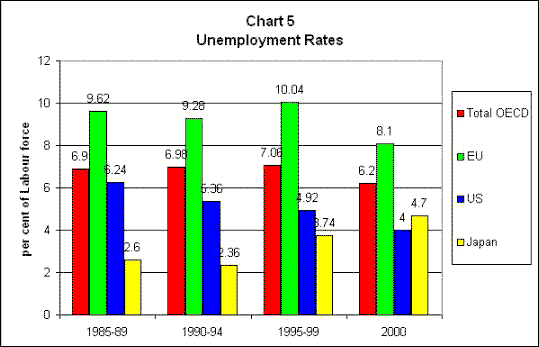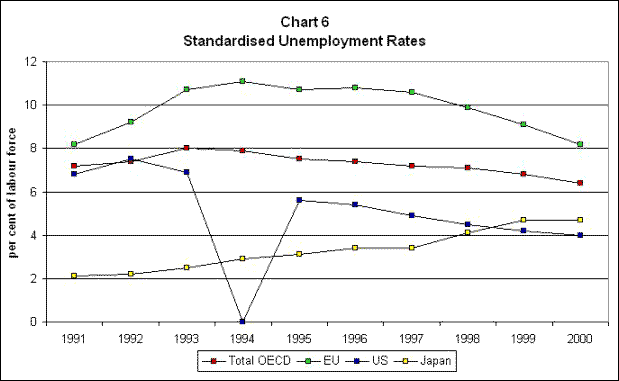|
The role of unemployment and employment
growth
Clearly,
therefore, it is necessary to investigate patterns of
employment and unemployment in the major advanced economies
more closely. Chart 5 show the unemployment rates (as
per cent of labour force) in the OECD economies, and
shows how in all the major countries except US, unemployment
rates have tended to increase over the latter part of
the 1990s.

Chart
5>>
Click to Enlarge
However, there are substantial differences in definition
and measurement of open unemployment across the OECD,
and therefore Chart 6 presents the standardised data
which tries to use similar definitions. This presents
a rather different picture. Thus, Japanese unemployment
rates appear to rise more sharply while European unemployment
rates appear to have fallen slightly.

Chart
6>>
Click to Enlarge
A major problem with such data is the growing presence
of the “discouraged worker effect”, whereby potential
workers and long term unemployed (especially but not
exclusively women) tend to drop out of the labour force
and therefore disappear from both numerator and denominator.
This problem has been evident in Europe for some time,
but there are indications that it has been growing in
the US as well in recent times. Thus the slight fall
in the unemployment rate in January 2002 from 5.8 per
cent to 5.6 per cent, has been widely attributed to
the “discouraged worker effect”.
Because of this, rates of aggregate employment growth
may be a slightly better indicator of labour market
conditions than open unemployment rates. Of course,
even these do not give us an idea of the nature and
quality of employment, as most governments increasingly
include a range of part-time and casual employment as
well, which may reflect distressed worker involvement.
Nevertheless, Chart 7 presents the evidence on rates
of employment growth in the major OECD countries.

Chart
7>>
Click to Enlarge
The picture that emerges is that of fluctuating rates
of expansion, but overall a fairly dismal performance.
The other point to note is that the employment expansion
of the US economy is not all that impressive in comparative
perspective, and has been less than 2 per cent per annum
over the past five years on average.
This is confirmed by the rather rough estimates of employment
elasticity of aggregate output (per cent change in employment
by per cent change in real output) that are provided
in Chart 8. Once again, after the early 1990s,
the US economy does not emerge as considerably more
dynamic than other OECD countries in terms of generating
more employment. (It should be noted, however, that
the figure of 1 for the European Union for the period
1990-94 is misleading, for it refers to a period when
both output and employment growth were mildly negative.)
In fact, in recent years the employment elasticity of
output growth in the US economy appears to have been
very low.

Chart
8>>
Click to Enlarge
This points to a major structural weakness of the past
growth pattern, which is likely to have important effects
on the prospects for early recovery in the developed
world. As long as basic employment conditions do not
improve, attempts to generate economic expansion by
encouraging private savings and investment – such as
in the form of tax cuts and easy money through low interest
rates - are likely to falter. This is because those
in employment are likely to guard against the possibility
of future job loss by saving more rather than spending
more. To counter such a tendency, fiscal packages have
to be not only very large but also explicitly directed
at job creation. This has not been the case so far in
either US or Japan, while in Europe the fiscal stimulus
has in any case been weak.
In addition to this, there are other reasons why it
may be futile to expect another US-led boom to bring
about a recovery in the world economy once again. After
all, the current recession in the US reflects the collapse
of a speculative bubble, and it would be strange if
the economy could immediately create another such bubble
to generate that kind of economic growth.
At present, the bursting of the bubble involves the
corporate sector cutting back investment because of
overcapacity and the household sector reducing its consumption
because it is already financed by record levels of private
debt. A rapid reversal of these tendencies is not only
unlikely, but it would also require additional international
financing, with the rest of the world’s savings once
again rushing in to maintain high levels of US consumption
and economic activity.
An
increase in US growth levels sufficient to lift the
world economy would lead to a further rapid widening
of the US balance of payments deficit, which is already
at more than 4.5 percent of GDP. Such a payments gap
would in turn require an increased financial inflow
from the rest of the world to sustain it. But the rest
of the world already provides nearly $2 billion per
day in their savings to the US economy. It is difficult
to see how this can be increased in a wider international
context of lower income growth and stagnant employment
generation.
Clearly, the only feasible solution for international
capitalism is concerted expansion, directed by a responsible
world “leader” who would behave in a Kindleberger fashion
to organise such an expansion. But the current international
political economy suggests that such a solution is not
feasible or likely at the moment. Therefore, some sort
of world depression does indeed seem likely.
|

